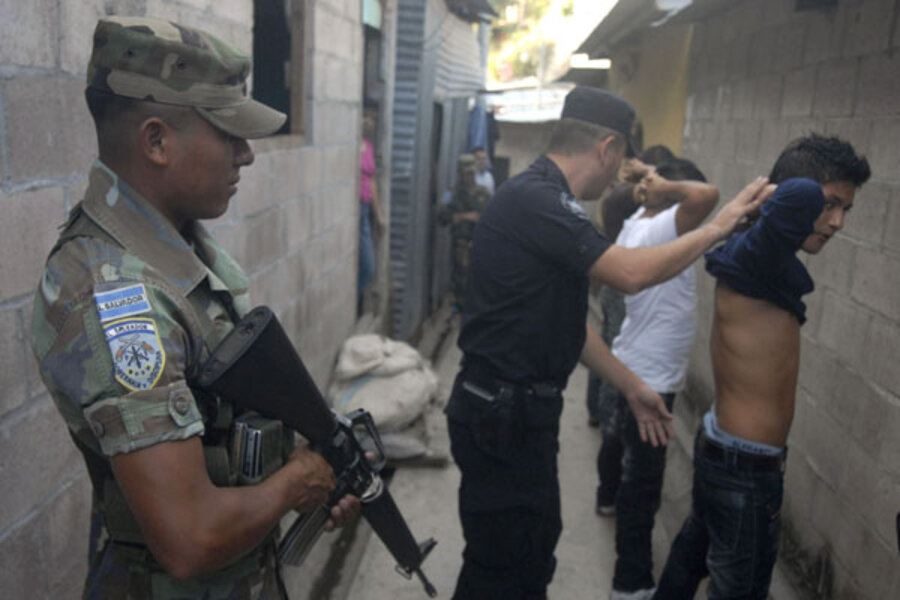Street gangs on the rise in South America: Are Central America's 'Maras' among them?
Loading...
• A version of this post ran on the author's site, Insightcrime.com. The views expressed are the author's own.
In recent years, officials have expressed increasing concern about the influence of Central American street gangs, known as “maras,” in South America; but while street gangs are on the rise in the region, they are a different beast.
On May 25 last year, 19-year-old Peruvian Oscar Barrientos shot and killed his father in their home in Callao, a city just west of Lima. When Peruvian police arrested him last month, however, his confession was less shocking than his reported motive. According to officials, Barrientos considered himself a member of the Mara Salvatrucha (link in Spanish) – also known as MS-13 – and may have killed his father as part of an initiation rite into the gang (see original post for photo of his tattooed lower lip). This revelation set off a wave of speculation in Peru on the influence of the Central American street gang in the country, and prompted local police to claim that Callao is home to at least one MS-13 crew of about 20 individuals.
Alarm over the spreading influence of Central American “maras” is nothing new. Groups like MS-13 and their rivals, Barrio 18, have expanded across Central America, as well as operating in Mexico and the United States. In recent years, analysts have become concerned about the potential for their growth in South America. Since as far back as 2005, US law enforcement officials have been warning that cells of the Mara Salvatrucha have sprung up in Ecuador, and there have been reports of members of both the MS-13 and Barrio 18 in countries as distant as Bolivia, Venezuela and even Argentina.
But while there may be small cells active in these countries, these groups do not pose anything like the same menace that they do in Central America. Claims to the contrary overlook a primary feature of the maras’ history: the fact that they first formed in the US, and that their spread throughout Central America is due mostly to a wave of deportations of gang members from the US that began in the 1990s.
Both MS-13 and M-18 began as small scale street gangs made up of mostly Central American (and some Mexican) migrants in the barrios, or slums, of Los Angeles in the late 1980s. They eventually became some of the most powerful gangs in the California prison system. By the end of the 1990s, the US started to see these groups as a serious criminal threat. Partly as a result, the Clinton administration significantly strengthened US deportation policies, beginning to send large numbers of foreign-born convicts back to their home countries.
This resulted in a spike in the number of gang members being sent to El Salvador, Honduras, Guatemala, and elsewhere. By some estimates, as many as 20,000 criminals were sent to Central America between 2000 and 2004, and the trend has continued to this day. Sources in US law enforcement have told InSight Crime that around 100 ex-convicts are deported every week to El Salvador alone.
But because South American migrants never formed a significant portion of the membership of these LA gangs, large-scale maras are not likely to develop south of the Darien Gap. However, this is not to say that domestic gangs are not a major threat to security in South America. Countries across the continent are seeing a steady rise in the incidence of homicides, extortion, drug distribution, and kidnapping, mostly driven by urban street gangs.
In countries like Colombia and Brazil, which are plagued by more organized criminal groups, the problem is more complex. These organizations often “subcontract” street gangs to serve as their enforcers, using them to cement their control over urban areas. Like the groups in the US, many South American gangs use prisons as a kind of home base and recruiting ground. Prisons in Venezuela, Brazil and Bolivia are often almost entirely controlled by the gangs themselves, and it is not uncommon for gang leaders to run their organizations from behind bars.
South American street gangs may not be as notorious as Central America’s maras, but they pose a significant threat to security. What’s more, it could be set to worsen. UN officials have warned of a surge of cocaine consumption among youths in South America, led by Uruguay, Chile and Argentina (link in Spanish). With the domestic market rising, the incentive to control it is higher, meaning that gang violence in the region could become even more serious.
– Geoffrey Ramsey is a writer for Insight – Organized Crime in the Americas, which provides research, analysis, and investigation of the criminal world throughout the region. Find all of his research here.
Get daily or weekly updates from CSMonitor.com delivered to your inbox. Sign up today.







